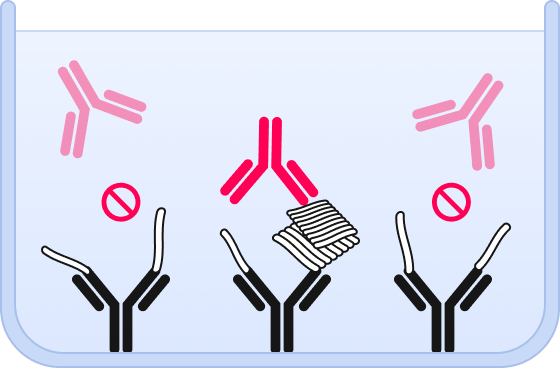our science
sFIDA is a platform technology for quantitation and sizing of single protein aggregates at unprecedented levels of sensitivity and specificity.
sFIDA: Surface-based Fluorescence Distribution Analysis
The sFIDA platform technology provides a cutting-edge approach for the quantitative detection of single oligomers and aggregates that serve as biomarkers for CNS diseases such as Alzheimer’s disease and Parkinson’s disease. The platform combines the precision of selective immunoassays with the superior sensitivity of fluorescence microscopy to count individual particles. As a result, sFIDA enables detection of these biomarkers with unprecedented sensitivity and specificity.
The versatility of the sFIDA platform is demonstrated by its successful application across a variety of conditions and biological matrices, including brain homogenate, cerebrospinal fluid, blood plasma, and even stool samples. This broad applicability makes sFIDA a powerful tool in both clinical and research settings, advancing the molecular understanding of neurodegenerative disorders.
How it works

❶ Wells are chemically modified to bind a capture antibody and sample is added.

❷ Both, oligomers and monomers are bound by the capture antibody.

❸ Using the same epitope for capture and detection, only oligomers are probed – but no monomers.

❹ Individual oligomers are detected and counted by highly sensitive fluorescence microscopy.
In addition, the sFIDA platform holds significant promise for advancing drug development. By providing valuable insights into the pathogenesis of CNS diseases and the molecular underpinnings of neurodegenerative disorders, sFIDA technology can aid in the identification of novel therapeutic targets and the evaluation of drug efficacy.
The sFIDA platform technology was developed at the Forschungszentrum Jülich, a leading research institute in Germany. Since 2018, the technology is commercialized by the spin-off company attyloid GmbH, which is dedicated to providing innovative solutions for the detection and analysis of biomarkers associated with neurodegenerative diseases.

attyloid is more than a biotech company.
We are an academic spin-off dedicated to the scientific rigor that the complex fields of protein misfolding and CNS diseases demand. Our research plays a critical role in diagnosing and understanding these diseases and paving the way for innovative therapeutics.
Peer-reviewed publications
At attyloid, we recognize the value of peer-reviewed science. Our research has been published in leading journals, establishing a strong reputation in the field of protein misfolding and aggregation. The proprietary sFIDA technology platform distinguishes us through its ultra-sensitive, quantitative capabilities, which have been rigorously validated in peer-reviewed studies — ensuring exceptional accuracy and reliability.